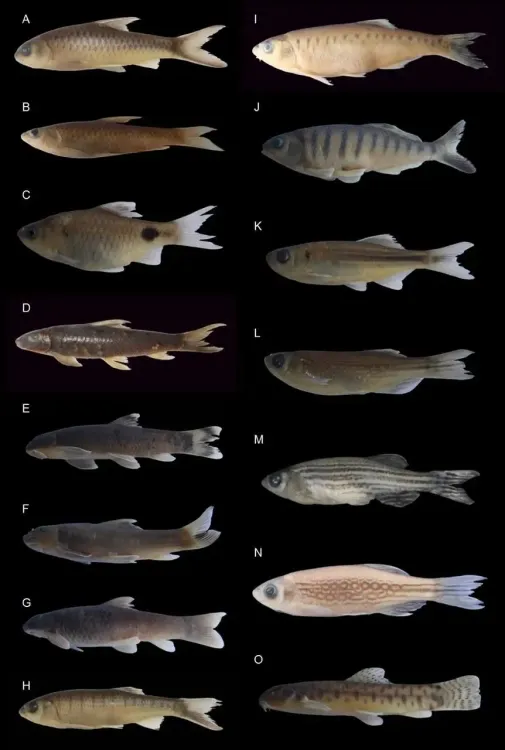Researchers at Nagaland University Join Forces with Local Communities to Safeguard Indigenous Fish Species

Synopsis
Key Takeaways
- Collaboration with local communities enhances research.
- Dikhu River is vital for biodiversity and economy.
- Urgent conservation efforts are needed due to human threats.
- Documenting fish species supports targeted conservation.
- Seasonal patterns in fish diversity were identified.
Kohima, March 25 (NationPress) Researchers from Nagaland University are working alongside local communities to investigate and protect indigenous fish species in the Dikhu River, as reported by officials on Tuesday.
An official from the university mentioned that this research incorporates traditional ecological knowledge gathered from local villagers to enhance understanding of fish diversity, species assessment, indigenous fishing methods, and community-led fishing practices, which is a rare approach in the scientific studies within the region.
The Dikhu River, which traverses the Mokokchung and Longleng districts of Nagaland, serves as a significant tributary of the Brahmaputra River and hosts numerous freshwater species critical for local biodiversity and economic stability.
The study highlighted an urgent necessity for concentrated conservation initiatives in Nagaland’s river systems, with the official noting that these ecosystems harbor a unique and rich biodiversity but are increasingly threatened by human encroachment and unsustainable practices.
The research pointed out that the Dikhu River is crucial not only for local populations but also plays a pivotal role in broader global conservation efforts.
The research team, comprising members from the Zoology Department at Nagaland University (Lumami Campus) and ICAR-National Bureau of Fish Genetic Resources in Lucknow, aimed to explore and document the ichthyofaunal diversity of the Dikhu River.
They concentrated on the lack of comprehensive data regarding fish species in the river and the significant threats these species encounter due to human-induced pressures such as habitat destruction, overfishing, and harmful fishing methods.
Funded by ICAR-National Bureau of Fish Genetic Resources, the study documented 28 fish species across 6 orders, 13 families, and 3 subfamilies, with Cypriniformes being the most prevalent order (67.9 percent).
Dr. Pranay Punj Pankaj, Associate Professor in the Zoology Department at Nagaland University (Lumami Campus), alongside research scholar Metevinu Kechu, spearheaded the research, which has been published in esteemed journals.
Dr. Pankaj emphasized the importance of this research, stating: "The study is crucial as the Dikhu River and its fish species have not received adequate attention in scientific literature. Therefore, this research significantly contributes to the existing knowledge regarding the freshwater ecosystems of northeastern India."
The results are essential for conservation strategies aimed at protecting freshwater biodiversity in northeastern India, recognized as a biodiversity hotspot. Documenting threatened fish species and their population dynamics will aid in targeted conservation measures, he explained.
Dr. Pankaj further mentioned the necessity for collaborative efforts among local communities, conservationists, and government entities to ensure the sustainability of river ecosystems. Stricter regulations on destructive fishing practices, habitat protection, and the advocacy of traditional, sustainable fishing methods are crucial for an integrated conservation strategy.
The research underscores that numerous species are under threat from over-exploitation, habitat degradation, and pollution due to human activities, emphasizing the urgent need for stronger conservation measures to protect these vital aquatic resources.
The research team also aims to propose solutions for enhancing fish conservation, including promoting sustainable fishing practices, restoring habitats, and leveraging traditional ecological insights from local communities.
Moreover, the study intends to identify and document the conservation status and population trends of these fish species, particularly those that are threatened in the region.
In contrast to many studies, this research assesses seasonal variations in fish diversity and relative abundance, providing a temporal insight into how fish populations fluctuate throughout the year. The research identified seasonal trends in fish abundance, with the post-monsoon season exhibiting the highest fish diversity and abundance.
Additionally, this research team documented the first-ever sighting of Garrabirostris, a freshwater fish previously located in Arunachal Pradesh, Assam, and Bhutan, now observed in the Doyang and Dikhu rivers. This discovery further enriches Nagaland’s ichthyofauna and emphasizes the ecological importance of these river systems in sustaining biodiversity.









